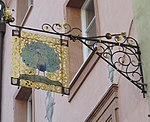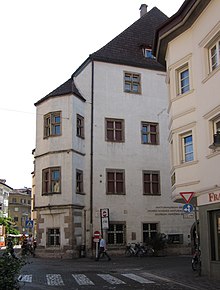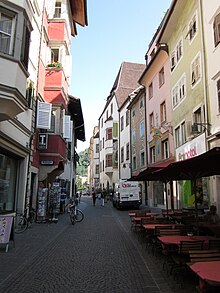Bindergasse (Bolzano)
The Bindergasse ( Italian Via Bottai ) is one of the oldest streets in the city of Bolzano .
history
Around 1210, about 30 to 40 years after the establishment of the urban market settlement of Bolzano , the Lords of Wangen (the brothers Albero and Bertold) initiated an expansion of the city on their land in the east and northeast of the episcopal market. Her brother Friedrich von Wangen was then Bishop of Trento . In this way, the gentlemen of Wangen were able to secure lower jurisdiction for the new suburb. Bindergasse was laid out with today's Vintlerstraße and the eastern front of today's Weintraubengasse, probably around 1215. The Bindergasse was called the front street . After the amalgamation of the episcopal old town and the two suburbs, the name Wangergasse prevailed, which was later reinterpreted as Wagnergasse (after the trade of Wagner ). The total Tyrolean Urbar Count Meinhard II. Of 1288 recorded princely possessions in the gazzen men Beraldi de cheek , the Office for Gries is expected. In the year 1297 the street is called contrata dominorum de Wanga in the city documents , 1403 as Wangergazze and 1499 as Wangergassen . Probably not until the 18th century, the Bindergasse (- designated "tie" the occupation of [barrel] after in Bolzano as was made Wagnergasse Cooper ).

There were several inns in Bindergasse very early on, the oldest being the “Pfau”, which recently only operated as a bar and was finally closed in 2009. Thus, according to their own statement, the “White Horse Inn” in Bindergasse is the oldest inn in the city of Bozen. Other historic restaurants in Bindergasse are the "Eisenhut" restaurant and the Hotel Mondschein. These can also be recognized by the historical pub signs; the nasal shield is also the only one that reminds of the former “zum Schlüssel” inn.

Under King Maximilian I , the Prince's Office was built at the northern end of Bindergasse around 1500 . According to Beda Weber , Maximilian occasionally used the house as a residence. The post office was later set up in the office building, and in autumn 1850 the post office became the post and telegraph office. In 1890 the post office was moved to the new post office opposite the parish church, where the main post office and the Bolzano branch of the post office are still located today. The building opposite the office building belonged to the diocese of Augsburg around 1600 and was named St. Afra House after its patroness . In 1803 it passed to the then Bavarian rulership, which had the Bozen prison set up there. The freedom fighters Andreas Hofer and Peter Mayr were also briefly imprisoned here in 1810 . The house, which was largely destroyed in the Second World War, was rebuilt true to the original, but the deep cellars survived the bombardment unscathed.
At the northern end of the street was the so-called Vintlertor , first mentioned in 1273 , where Zollstrasse (today Andreas-Hofer-Strasse ) meets from the Zollstange and Weggensteinstrasse from the “Malgrei” (districts) of Dorf and St. Peter. The Weggensteinstraße was mainly used by the Sarners up to the middle of the 20th century to get to Bozen. That is why there was a farrier in Bindergasse who looked after and took in the Sarner horses. Later it was the terminus of a city bus route. The many inns on the street were due to the importance of traffic on the street.
In the 19th century the so-called Ritsche or Wiere (a canal to supply the houses with usable water ), which until then ran openly through the street, was built.
Bindergasse today
Bolzano has long since ceased to be a cooper or a cooper. The Bindergasse has largely retained its historical appearance, even if some buildings have been given new uses; The Prince's Office House became the South Tyrol Natural History Museum , the St. Afra House became a house with apartments for self-employed seniors, and the “Weißes Rössl” inn has given up its accommodation function and relies on down-to-earth cuisine. The party headquarters of the South Tyrolean Greens is located on the upper floor of the “Pfauen” . In addition to the restaurants already mentioned, there are three other bars and a pizzeria. Several bakeries and bread shops line the street. There is also a supermarket in Bindergasse, the headquarters of the ASGB and the department for Ladin School and Culture. Bindergasse is now part of Bolzano's pedestrian zone, but taxis and (at certain times) suppliers and residents can use it in a northerly direction.
literature
- Josef Weingartner : The art monuments Bolzano . Vienna-Augsburg: Hölzel 1926, p. 138 f. (on-line)
Individual evidence
- ↑ Karl Theodor Hoeniger : Altbozner picture book. 100 illustrations and 40 essays on the city's history . 3. Edition. Bolzano: Ferrari-Auer 1968, pp. 77-78.
- ↑ Mahlknecht, Bruno: Bozen through the centuries . tape 1 . Athesia Spectrum, Bozen 2005, ISBN 88-6011-020-3 , From the episcopal market to the city magistrate, p. 41 ff .
- ↑ Mahlknecht, Bruno: Bozen through the centuries . tape 2 . Athesia Spectrum, Bozen 2006, ISBN 88-6011-021-1 , The Bozner city arms, p. 27 .
- ↑ a b Mahlknecht, Bruno: Bozen through the centuries . tape 3 . Athesia Spectrum, Bozen 2006, ISBN 88-6011-027-0 , all kinds of interesting things ; here and there in the alleys of the old town of Bolzano, S. 181 ff .
- ^ Oswald Zingerle (Ed.): Meinhards II. Urbare der Grafschaft Tirol. (= Fontes Rerum Austriacarum, Diplomataria et acta 55 / I). Vienna 1890, p. 119, No. 60.
- ^ Hannes Obermair : Bozen Süd - Bolzano Nord. Written form and documentary tradition of the city of Bozen up to 1500 . tape 1 . City of Bozen, Bozen 2005, ISBN 88-901870-0-X , p. 132, No. 133 .
- ^ Hannes Obermair: Bozen Süd - Bolzano Nord. Written form and documentary tradition of the city of Bozen up to 1500 . tape 2 . City of Bozen, Bozen 2008, ISBN 978-88-901870-1-8 , p. 40, No. 910, u. P. 242, no. 1342a .
- ↑ Joseph von Hormayr : The collector for history and statistics of Tyrol . 5th volume. Innsbruck 1809, p. 17 ( google books [accessed March 17, 2018]).
- ^ Hannes Obermair: The Bozen city book. Manuscript 140 - the official and privileges book of the city of Bolzano . Contributions to the international study conference, Bozen, Maretsch Castle, 16. – 18. October 1996. In: Bolzano from the Counts of Tyrol to the Habsburgs - Bolzano fra i Tirolo e gli Asburgo (= research on the history of Bolzano / Studi di storia cittadina ). tape 1 . Athesia, Bozen 1999, ISBN 88-7014-986-2 , p. 399-432, here: p. 415 .
- ↑ White Horse Inn restaurant. Retrieved August 21, 2010 .
- ^ Beda Weber : The city of Bozen and its surroundings . G. Ferrari, Bozen 1849, ISBN 88-7014-459-3 , XV .: The inner city area ..., p. 197 .
- ↑ a b Mahlknecht, Bruno: Bozen through the centuries . tape 2 . Athesia Spectrum, Bozen 2006, ISBN 88-6011-021-1 , a telegraph office was opened in Talferstadt in 1850, p. 115 ff .
- ↑ South Tyrol's Monument Browser - Bindergasse 2
- ↑ K. Th. Hoeniger: Altbozner Bilderbuch (op. Cit.), P. 72 u. 191.
Web links
Coordinates: 46 ° 30 ′ 1.9 ″ N , 11 ° 21 ′ 24.5 ″ E

